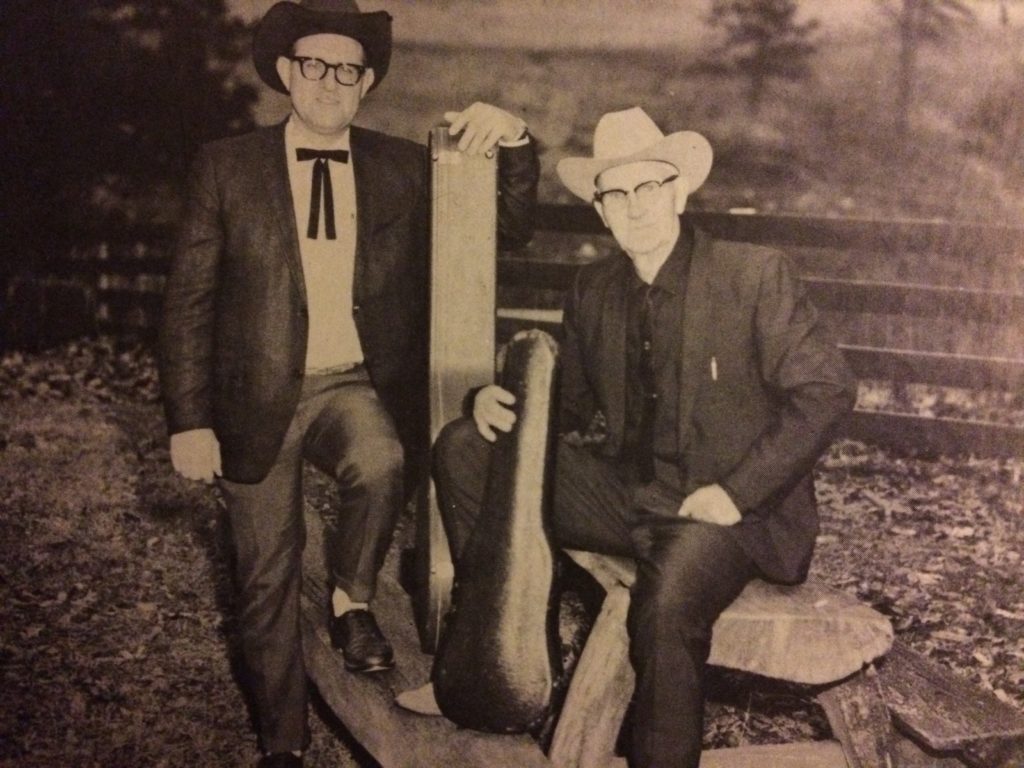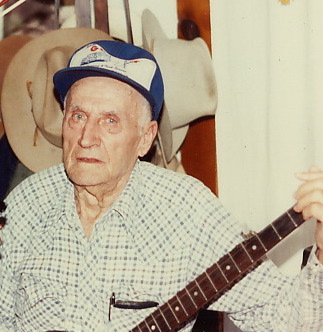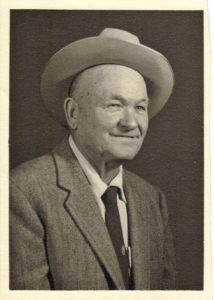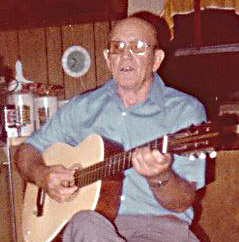John Dee Kennedy of Pawnee, Oklahoma – FRC738
By Brad Leftwich
In addition to the fiddlers mentioned in the main article, who were his mentors or who directly influenced his playing, John Kennedy played music and associated with a number of other musicians in Pawnee and Osage Counties back in the day.
Uncle Dick Hutchison

Dick Hutchison on the right, with guitar player Charles Carr. Photo from Dick’s album, Old Time Fiddlin.
Certainly the best known was Dick Hutchison (1897-1986). It’s hard to overstate the high regard in which fiddlers held “Uncle Dick” in the area where Oklahoma, Missouri, Kansas, and Arkansas meet. He had a clean, smooth style and could execute the latest rags and blues tunes with the same facility as he could the older breakdowns.
Dick was born in 1897 in McDonald County, the southwestern-most county in Missouri. His father, Jefferson Davis Hutchison (1864-1934), was also a fiddler – the source of Dick’s “Sally Johnson” among other tunes. When statehood opened Indian Territory to white settlement 10 years later, the family moved just over the state line to Delaware County, Oklahoma.
Dick spent his youth in the northeast corner of Oklahoma, briefly working in the lead and zinc mines that were the cornerstone of the area’s economy. According to census records, he registered for the draft during World War I, but was never called up. After the war, he moved with his family a hundred miles west to Osage County. He lived, farmed, and played music there for nearly two decades. When Tom Carter and Gary Stanton visited him in 1976, he named old Osage County fiddlers such as Ned Swift, Tom Brannon, and Warren Trosper as the sources for a number of his tunes.
This, of course, was John Kennedy’s stomping ground, and the years between 1920 and 1940, when Dick made his home in Osage County, mark the same period of time that John was learning to play and most actively pursuing his music. John would have had frequent opportunities to hear Dick play at dances, contests, fox-hunts, and other events featuring music in the area. John told us, “I used to play pretty much all of Dick’s tunes.”
Just before 1940, Dick and his wife moved back to northeastern Oklahoma and remained there the rest of their lives.
Cliff Trisler
Dick Hutchison’s music appealed across the spectrum to old-time dance fiddlers like John Kennedy as well as to those who were more oriented to Western swing and other modern forms of fiddling. One of the Western swing-style fiddlers enamored of Uncle Dick’s music was John’s rival and friend, Cliff Trisler (1911-2009).
Born in northeastern Oklahoma in 1911, Cliff was only one year old when his family came by wagon to Osage County. His mother died in 1920, leaving him an orphan at age nine. He lived variously with his sister and other families, eventually finding in music a way of grounding himself. Tenor banjo was his first instrument, and he played professionally for a while. Eventually he settled down to a full-time job at Bareco Oil Company and took up fiddling for fun.
Linda and I met Cliff at a festival in June of 1982. He lived just outside the Osage County town of Barnsdall, which is notable for the oil well in the middle of Main Street. Barnsdall was also Dick Hutchison’s home in the late 1920s and early 1930s, and, next to Bob Wills, Cliff idolized him more than any other fiddler.
Cliff Trisler was pretty much John Kennedy’s opposite. John loved the older styles of breakdown fiddling; Cliff, although three years older, was a fan of the more modern Western swing style. John was shy and self-effacing; Cliff was aggressive and self-confident. John used his bow gently; Cliff played hard and loud. Everything about Cliff was unapologetic, from the silver-capped toes of his boots to his big Western belt buckle, on up to his cowboy hat adorned with a fan of feathers. His tenor banjo was a force to be reckoned with in a jam session.
Although Cliff was outgoing and agreeable, John hated to see him arrive at contests. Cliff’s strong, jazzy style of fiddling tended to go over better with the judges than did John’s more subtle, archaic approach to the instrument. Cliff’s obituary claims he won more than 100 competitions.
Carol Kennedy Hendrix reflected on her father’s musical relationship with Cliff:
“Well, he was always Daddy’s rival, I guess you’d say. They’d play together everywhere they’d go. But Daddy would come home and say, ‘that ol’ Cliff Trisler,’ said ‘he wins everywhere he goes.’ Daddy sometimes wouldn’t bear down and play really loud. That’s what they’d always tell him at contests: ‘Now John, you need to get up there and you really need to bear down on that.’ Well Daddy couldn’t do it, he couldn’t play that way. To me, Daddy’s playing came across so pretty and smooth. And so when I hear these other men like Sam Pim, and mainly Cliff Trisler, boy, I mean they just about break your eardrums! I guess I was just so used to Daddy.”
They may have been rivals, but the two men liked each other. Carol continued,
“I have a video at our last family reunion before dad died, he and some fellas from Cleveland [Oklahoma] played the fiddle and we all danced, it was a wonderful time. And ol’ Cliff Trisler was there. I asked daddy why in the world he invited him. Daddy just laughed and said, ‘He’s a good person and real good fiddler, he just plays better then me.’ Well now that ain’t the truth! My daddy could play ol’ Cliff under the table. But I guess I’m a little prejudiced, huh?”
Ed Guthrie
As Linda and I sat visiting and exchanging tunes with John Kennedy during our first visit on New Year’s Eve day in 1982, Ed Guthrie (1905-1993) knocked on the door. Ed was 77, retired, and enjoyed strolling around Pawnee of an afternoon, dropping in on friends or relatives for a visit. John introduced him to us as his cousin.
Ed’s father, fiddler John Will Guthrie, had married John Kennedy’s aunt Rachel Bryant way back in 1886, in Laurel County, Kentucky, and the two extended families moved together from Kentucky to Arkansas, and eventually to Oklahoma. Ed and John had known each other pretty much all their lives. Ed projected an air of gravitas, but he had a familial way of relating to John that eased the latter’s shyness around us.
Born in 1905 in Red Star, Arkansas, atop the Devil’s Backbone in the Boston Mountains, Ed had played the banjo when he was younger. He learned on a fretless banjo made from an axle-grease box covered with possum skin and strung with twine. “There weren’t any guitars then, and we were too poor to afford a banjo,” he said. John and Ed had played a fair amount of fiddle and banjo music together at dances over the years.
We offered him our banjo and asked if he’d play for us. With the disclaimer that he was badly out of practice, he soldiered through a few tunes in a unique style that he described as “knocking and picking.” Ed told us that in the old days everyone knocked the banjo (an old term for frailing or clawhammer-style banjo). Then the five-string banjo went out of fashion for many years, and when it came back in with Earl Scruggs and bluegrass, everyone was finger picking. He was never able to make the transition completely, and ended up with his own style that incorporated elements of both.
Nearly all of the Guthries had been musicians, and John played many tunes he learned from them. Ed no longer played much himself, but he loved to sit in John’s living room and listen to him play the fiddle, requesting tunes, reminiscing, and offering up opinions about music.
Although (or perhaps because) he worked hard all his life, he was of the opinion that “a musician shouldn’t never have to work.” I chuckled out loud before I realized he wasn’t kidding. He shook his head gravely, explaining, “that’ll stiffen up his fingers, you know. I just don’t think a musician should have to work.”
He was also very definite that John wasn’t playing “Ten-Cent Piece” quite right – it was a Guthrie family tune, so he should know – but after John had played “Flop-Eared Mule,” Ed just sat there in satisfaction for a moment and said quietly, “Now that’s perfect. Couldn’t play it any better.”
The Miller Family
At one point, Ed asked John, “What’s the tune that old Samp Miller always played? That was such a good piece! You know, he played it, and Beanie would second after him. Always played with his eyes shut.” Ed was referring to Charles Sampson “Samp” Miller (1890-1979) and his son Clarence “Beanie” Miller (1911-1993), prominent members of the local music scene. Ed never did think of the tune.
Fiddling was a Miller family tradition. Typical of many settlers that wound up in Oklahoma, the family moved with every generation. Samp’s father, John David “J.D.” Miller (1856-1937), was originally from Illinois. Samp himself was born in southern Missouri in 1890. His son Beanie was born in Lincoln County, Oklahoma, in 1911. All three generations of the family moved to Pawnee County a few years later, around the time John Kennedy was born. They lived right in his neighborhood, between Skedee and Blackburn, where Samp farmed with workhorses and hauled his cotton by wagon to a gin in Skedee. Beanie, Samp, and J.D. all played fiddle as well as other instruments.
Recently I was able to get in touch with two of Samp’s grandsons, Ross Funkhouser and Chuck Miller. Ross wrote:
“Samp Miller was my grandfather and was quite an individual. Grandpa Samp played the fiddle and in later years the harmonica. He was very talented, and I used to love to visit him and listen to his music. My uncle Beanie used to accompany him at local dances with several musical instruments, and all of Beanie’s children inherited Samp’s and Beanie’s musical abilities.”
Beanie’s son Chuck Miller, himself a musician, wrote:
“Dad started playing with Grandpa Samp at five years old. I have his C.F. Martin guitar that he bought new in 1926. He played many a house and barn dance with it in Pawnee and Osage counties. Grandpa’s dad John David (J.D.) was a fiddler also, grandpa said. He was also in Blackburn. Dad loved to sing the blues. He could yodel and he always closed his eyes when playing the fiddle or guitar. I never saw a instrument he picked up that he couldn’t whale away on it.”
Carl and Linda Casey
Two musicians with whom John Kennedy enjoyed playing were Carl Casey (1920-1975) and his wife Linda. Although younger than John by only six years, Carl was in fact his nephew – the son of John’s half-sister Dora Bell Bryant and Bob Casey.
Carl’s cousin Lawrence Casey wrote to me, “We all knew him as ‘Buck’ because he had buck teeth. He was crippled and had deformed hands, and he played in several bands.”
Carol Kennedy Hendrix recalled, “he was born with deformed fingers, they were like fused together, and he had no toes on one foot. I don’t know how he managed, but let me tell you, that fellow could play the fiddle and guitar like you wouldn’t believe! The guitar was his specialty.”
Linda Casey (1926-2002), Carl’s wife, also seconded John’s fiddling on guitar, sometimes with her husband and sometimes by herself. Carol Hendrix remembered, “Oh, she was really, really good. Funny thing about her, though, when she played she about stomped a hole in the floor keeping time. She’d get so carried away her knee would be almost up to her chin!”
Sam Pim

Sam Pim in Old Sam’s Fiddle Shop. Photo by Paul S. Howell, courtesy Oklahoma Historical Society, Gateway to Oklahoma History.
One of John Kennedy’s biggest fans and supporters was the man who first directed us to him: Sam Pim. Sam was born in 1897 in Lucas County, Iowa. When he was still a child, probably at statehood in 1907, his family moved to Beaver County in the Oklahoma panhandle. Sam described becoming enamored of the fiddling he heard there at dances and learning to play himself. His mentor was “old man Mills,” who Sam told us was about 60 years old at the time. “Oh, I wish he was still alive. I play most of his pieces. Just me and one other old boy knows them.”
Sam was a World War I veteran who worked for the Postal Service. In 1928 Sam married Della Dyer of Prescott, Arizona, a divorcee with two children. They lived in Prescott, where Sam got a job as a postal carrier, but the marriage was short-lived. Tragically, Della died in 1931 after just three years of marriage and a year after the birth of their daughter. Sam then moved to Hominy, in Osage County, Oklahoma, where he lived most of the remainder of his life, working for the Post Office and indulging his passion for old-time fiddling. When we visited, he had a little terrier named Scotty.
Sam was thoughtful and well-spoken. Somewhere along the line he had lost the ends of two fingers on his left hand, but it didn’t stop him from fiddling, making and repairing fiddles, and painting landscapes. His interests were wide-ranging: he was as big a fan of violinist Fritz Kreisler as he was of fiddler John Kennedy. He taught himself luthiery by reverse engineering: when he found a fiddle he liked – such as the one John Kennedy played – he’d try to get permission to take it apart and take measurements. The instruments he made were very nicely crafted and had a good sound.
Carol Kennedy Hendrix tells a heart-warming story about Sam and his kindness:
About 1977 John’s wife Leona (Carol’s mother) was diagnosed with cancer. Her pain medication was more than they could afford, and John was getting into debt. Carol discovered that her father had sold his fiddle to Sam Pim to raise money. Sam didn’t want to buy the fiddle but was afraid if he didn’t, someone else would, and the fiddle would be gone forever. Sam planned to hold onto it until John could buy it back.
Carol and her husband had three kids and not much money. He was in school to become an automotive mechanic and had just bought a brand-new set of tools. It was a week before Christmas, and they devised a plan: Sam agreed to take the tools in exchange for the fiddle, with the understanding that they would buy back the tools in small installments over time.
They surprised John by giving him back his fiddle for Christmas, and it was a happy, teary-eyed occasion. The capper came shortly thereafter, when Sam gave the tools back to Carol’s husband and said they didn’t owe him anything. “It was the best Christmas I’ve ever had in my life,” Carol told me.
*****




